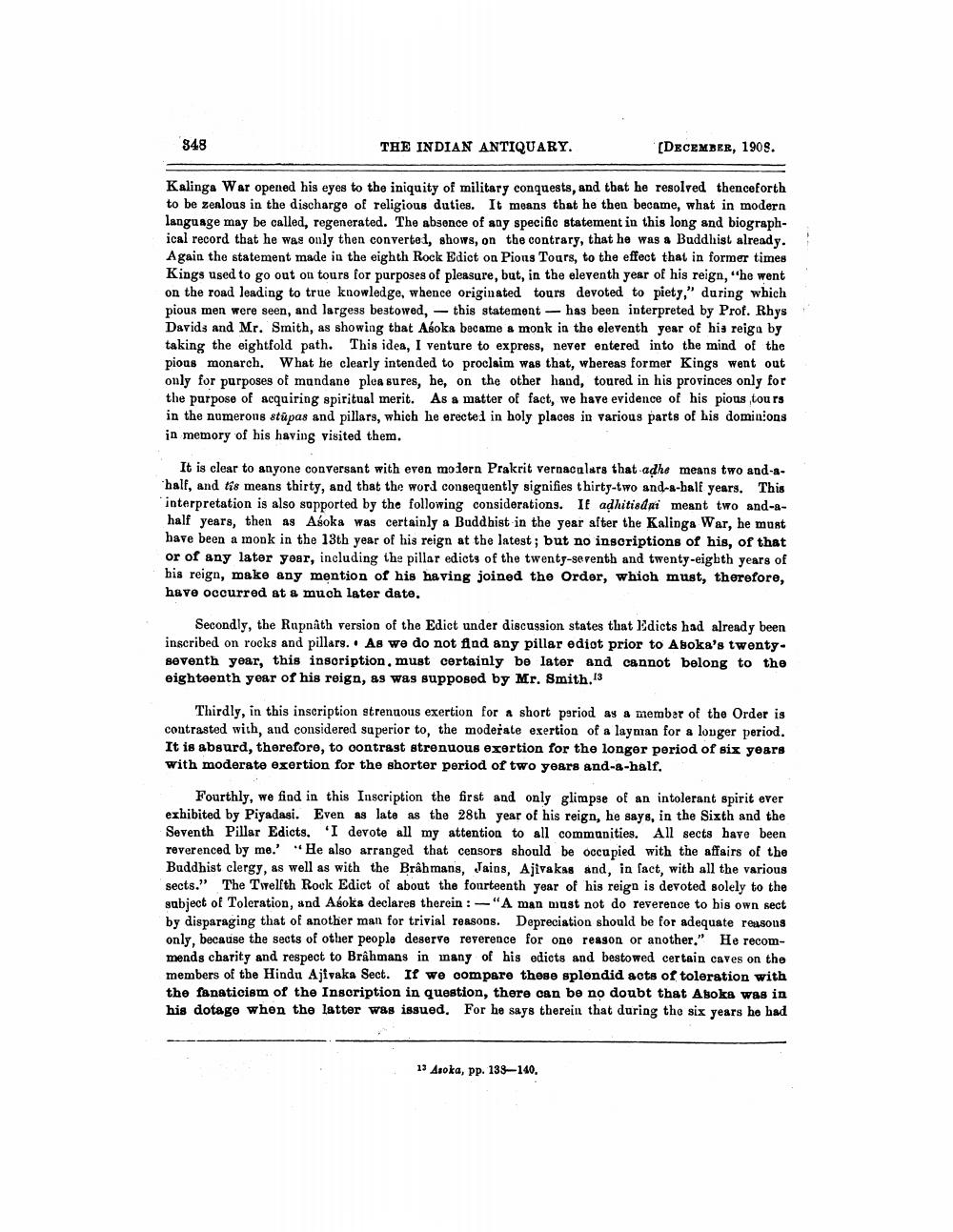________________
848
THE INDIAN ANTIQUARY.
[DECEMBER, 1908.
Kalinga War opened his eyes to the iniquity of military conquests, and that he resolved thenceforth to be zealous in the discharge of religious duties. It means that he then became, what in modern language may be called, regenerated. The absence of any specific statement in this long and biographical record that he was only then converted, shows, on the contrary, that he was a Buddhist already. Again the statement made in the eighth Rock Edict on Pions Tours, to the effect that in former times Kings used to go out on tours for purposes of pleasure, but, in the eleventh year of his reign, "he went on the road leading to true knowledge, whence originated tours devoted to piety," during which pious men were seen, and largess bestowed, this statement has been interpreted by Prof. Rhys Davids and Mr. Smith, as showing that Aśoka became a monk in the eleventh year of his reign by taking the eightfold path. This idea, I venture to express, never entered into the mind of the pious monarch. What he clearly intended to proclaim was that, whereas former Kings went out only for purposes of mundane plea sures, he, on the other hand, toured in his provinces only for the purpose of acquiring spiritual merit. As a matter of fact, we have evidence of his pious tours in the numerous stupas and pillars, which he erected in holy places in various parts of his dominions in memory of his having visited them.
It is clear to anyone conversant with even modern Prakrit vernaculars that aḍhe means two and-ahalf, and tis means thirty, and that the word consequently signifies thirty-two and-a-half years. This interpretation is also supported by the following considerations. If adhitisdai meant two and-ahalf years, then as Asoka was certainly a Buddhist in the year after the Kalinga War, he must have been a monk in the 13th year of his reign at the latest; but no inscriptions of his, of that or of any later year, including the pillar edicts of the twenty-seventh and twenty-eighth years of his reign, make any mention of his having joined the Order, which must, therefore, have occurred at a much later date.
Secondly, the Rupnâth version of the Edict under discussion states that Edicts had already been inscribed on rocks and pillars. As we do not find any pillar edict prior to Asoka's twentyseventh year, this inscription, must certainly be later and cannot belong to the eighteenth year of his reign, as was supposed by Mr. Smith, 13
Thirdly, in this inscription strenuous exertion for a short period as a member of the Order is contrasted with, and considered superior to, the moderate exertion of a layman for a longer period. It is absurd, therefore, to contrast strenuous exertion for the longer period of six years with moderate exertion for the shorter period of two years and-a-half.
Fourthly, we find in this Inscription the first and only glimpse of an intolerant spirit ever exhibited by Piyadasi. Even as late as the 28th year of his reign, he says, in the Sixth and the Seventh Pillar Edicts. 'I devote all my attention to all communities. All sects have been reverenced by me.' He also arranged that censors should be occupied with the affairs of the Buddhist clergy, as well as with the Brahmans, Jains, Ajivakas and, in fact, with all the various sects." The Twelfth Rock Edict of about the fourteenth year of his reign is devoted solely to the subject of Toleration, and Aśoka declares therein: "A man must not do reverence to his own sect by disparaging that of another man for trivial reasons. Depreciation should be for adequate reasons only, because the sects of other people deserve reverence for one reason or another." He recommends charity and respect to Brâhmans in many of his edicts and bestowed certain caves on the members of the Hindu Ajivaka Sect. If we compare these splendid acts of toleration with the fanaticism of the Inscription in question, there can be no doubt that Asoka was in his dotage when the latter was issued. For he says therein that during the six years he had
13 Asoka, pp. 133-140.




